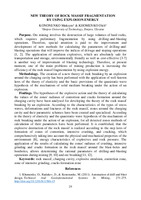Показати скорочений опис матеріалу
NEW THEORY OF ROCK MASSIF FRAGMENTATION BY USING EXPLOSION ENERGY
| dc.contributor.author | Kononenko, M. | |
| dc.contributor.author | Khomenko, O. | |
| dc.date.accessioned | 2021-04-01T09:42:05Z | |
| dc.date.available | 2021-04-01T09:42:05Z | |
| dc.date.issued | 2020 | |
| dc.identifier.uri | http://ir.nmu.org.ua/handle/123456789/157649 | |
| dc.description.abstract | The hypotheses of the explosive action and the theory of calculating the values of the zones' radiuses of contortion and cracks formation around the charging cavity have been analyzed for developing the theory of the rock massif breaking by an explosion. According to the characteristics of the types of stress waves, deformations and fractures of the rock massif, zones around the charging cavity and their parametric schemes have been created and specialized. According to the theory of elasticity and the quasistatic-wave hypothesis of the mechanism of rock breaking under the action of an explosion, for all detected zones methods of calculation of their parameters have been performed. It is established, that the explosive destruction of the rock massif is realized according to the step laws of formation of zones of contortion, intensive crushing, and cracking, which comprehensively taking into account the physical-and-mechanical properties of the environment, energy characteristics of explosives and rock pressure. The application of the results of calculating the zones' radiuses of crushing, intensive grinding and cracks formation in the rock massif around the blast-holes and boreholes, allows determining the rational parameters of drilling-and-blasting operations during mining and ore breaking. | uk_UA |
| dc.language.iso | en | uk_UA |
| dc.subject | rock massif | uk_UA |
| dc.subject | charging cavity | uk_UA |
| dc.subject | explosive emulsion | uk_UA |
| dc.subject | contortion zone | uk_UA |
| dc.subject | zone of intensive grinding | uk_UA |
| dc.subject | cracks formation zone | uk_UA |
| dc.title | NEW THEORY OF ROCK MASSIF FRAGMENTATION BY USING EXPLOSION ENERGY | uk_UA |
| dc.type | Article | uk_UA |
| dc.identifier.udk | 622.235.5 | uk_UA |

